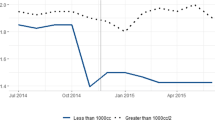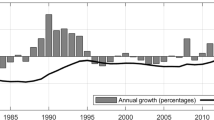Abstract
This paper uses novel data on the performance of loan pools underlying asset-backed securities to estimate a competing risks model of default and prepayment on subprime automobile loans. We find that prepayment rates increase rapidly with loan age but are not affected by prevailing market interest rates. Default rates are much more sensitive to aggregate shocks than are prepayment rates. Increases in unemployment precede increases in default rates, suggesting that defaults on subprime automobile loans are driven largely by shocks to household liquidity. There are significant differences in the default and prepayment rates faced by different subprime lenders. Those lenders that charge the highest interest rates experience the highest default rates, but also experience somewhat lower prepayment rates. We conjecture that there is substantial heterogeneity among subprime borrowers, and that different lenders target different segments of the subprime market. Because of their higher default rates, loans that carry the highest interest rates do not appear to yield the highest expected returns.
Similar content being viewed by others
References
Allison, P. D. (1982). “Discrete-time Methods for the Analysis of Event Histories,” In S. Leinhardt (ed.), Sociological Methodology. San Francisco: Jossey-Bass.
Ambrose, B., and A. B. Sanders. (2001). “Commercial Mortgage-backed Securities: Prepayment and Default,” Working Paper.
Calhoun, C. A., and Y. Deng. (2002). “A Dynamic Analysis of Fixed-and Adjustable-Rate Mortgage Termination,” Journal of Real Estate Finance and Economics 24(1), 9-33.
Deng, Y., J. M. Quigley, and R. Van Order. (2000). “Mortgage Terminations, Heterogeniety and the Exercise of Mortgage Options,” Econometrica 68(2), 273-307.
Elliehausen, G., and M. E. Staten. (2004). “Regulation of Subprime Mortgage Products: An Analysis of North Carolina's Predatory Lending Law,” Journal of Real Estate Finance and Economics 29(4), 411-433.
Gross, D. B., and N. S. Souleles. (2002). “An Empirical Analysis of Personal Bankruptcy and Delinquency,” Review of Financial Studies 15(1), 319-347.
Han, A., and J. A. Hausman. (1990). “Flexible Parametric Estimation of Duration and Competing Risk Models,” Journal of Applied Econometrics 5, 1-28.
Lancaster, T. (1990). The Econometric Analysis of Transition Data. Econometric Society Monographs, Cambridge University Press.
Malmquist, D., F. Phillips-Patrick, and C. Rossi. (1997). “The Economics of Low-Income Mortgage Lending,” Journal of Financial Services Research 11, 169-188.
OCC, FRB, FDIC, and OTS. (1999). “Interagency Guidance on Subprime Lending,” FDIC Press Release PR8a-99.
OCC, FRB, FDIC, and OTS. (2001). “Expanded Guidance for Subprime Lending Programs,” FRB Supervisory Letter 01-4.
Pavlov, A. D. (2001). “Competing Risks of Mortgage Termination: Who Refinances, Who Moves, and Who Defaults?” Journal of Real Estate Finance and Economics 23(2), 185-211.
Shumway, T. (2001). “Forecasting Bankruptcy More Accurately: A Simple Hazard Model,” Journal of Business 74(1), 101-124.
Stiglitz, J. E., and A. Weiss. (1981). “Credit Rationing in Markets with Imperfect Information,” American Economic Review 71(3), 393-410.
Sueyoshi, G. T. (1992). “Semiparametric Proportional Hazards Estimation of Competing Risks Models with Time-varying Covariates,” Journal of Econometrics 51, 25-58.
Author information
Authors and Affiliations
Rights and permissions
About this article
Cite this article
Heitfield, E., Sabarwal, T. What Drives Default and Prepayment on Subprime Auto Loans?. The Journal of Real Estate Finance and Economics 29, 457–477 (2004). https://doi.org/10.1023/B:REAL.0000044023.02636.e6
Issue Date:
DOI: https://doi.org/10.1023/B:REAL.0000044023.02636.e6




